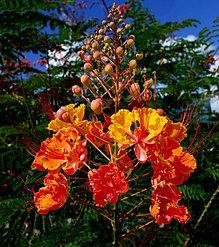-
CAESALPINIA PULCHERRIMA YELLOW
CAESALPINIA PULCHERRIMA YELLOW
Couldn't load pickup availability
MINIMUM TEMPERATURE SUPPORTED -7°C
(DATA REFERS TO AN ADULT PLANT IN OPTIMAL HUMIDITY AND SOIL CONDITIONS)
From Wikipedia, the free encyclopedia
Caesalpinia pulcherrima is a species of flowering plant of the Fabaceae family , native to the tropical and subtropical areas of the Americas . It may be native to the West Indies , [3] but its exact origin is unknown due to widespread cultivation. [2] Common names for this species include poinciana , peacock flower , red bird of paradise , Mexican bird of paradise , dwarf poinciana , pride of Barbados , flos pavonis , and flamboyant-de-jardin . [ citation needed ] The Hawaiian name for this plant is 'ohai ali'i . [4]
Description

It is a shrub that grows up to 3 m in height. In climates with little or no frost, this plant will grow larger and is semi-evergreen. In Hawaii this plant is evergreen and grows over 5 m in height. Grown in climates with light to moderate frosts, the plant will die to the ground depending on the cold, but will regrow in mid to late spring. This species is more sensitive to cold than others. The leaves are bipinnate, 20–40 cm long, bearing three to ten pairs of auricles, each with six to ten pairs of leaflets 15–25 mm long and 10–15 mm wide. The flowers are borne in racemes up to 20 cm long, each flower with five yellow, orange or red petals. The fruit is a pod 6–12 cm long.
Taxonomy
Poinciana pulcherrima is synonymous with Caesalpinia pulcherrima . [5]
Symbolism
Caesalpinia pulcherrima is the national flower of the Caribbean island of Barbados and is depicted in the upper left and right corners of Queen Elizabeth II's personal flag of Barbados .
Claire Waight Keller included Barbadian pride to represent the country in Meghan Markle's wedding veil , which included the distinctive flora of each Commonwealth country. [6]
Uses
Food
All Caesalpinia seeds are poisonous. However, the seeds of some species are edible before they reach maturity (e.g. immature seeds of C. pulcherrima ) or after treatment (e.g. C. bonduc after roasting). [7]
Traditional medicine
Maria Sibylla Merian , a 17th-century artist, encountered this plant in theDutch colony of Suriname . [8] In his work, Metamorphosis insectorum Surinamensium , Merian recorded that African slaves and native Indian populations used flos pavonis or peacock flower as an abortifacient in their practice of traditional medicine . [9] He wrote:
The Indians, who are not treated well by their Dutch masters, use the seeds [of this plant] to abort their children, so that their children will not become slaves like them. Black slaves from Guinea and Angola demanded to be treated well, threatening to refuse to have children. They told me so themselves. [10]
The leaves, flowers, bark and seeds of C. pulcherrima were also used by American Indians in traditional medicine as abortifacients and for suicide by enslaved populations. [8]
Ornamental
Caesalpinia pulcherrima is the most cultivated species of the Caesalpinia genus . It is a striking ornamental plant, widely grown in home and public gardens in warm climates with mild winters, and has a beautiful inflorescence in yellow, red and orange colors. Its small size and the fact that it tolerates pruning well allow it to be planted in groups to form a hedge ; It can also be used to attract hummingbirds . [11]
In cultivation in the UK this plant has achieved the Royal Horticultural Society 's Award of Gardening Merit . [12]
Gallery
-
orange red variant flower
-
Buds opening
-
Yellow flowers
-
"Peacock" flower.
-
Colors in the petals
-
whole pile of Caesalpinia pulcherrima
RICHIEDI FOTO
RICHIEDI FOTO
Scrivimi su WhatsApp al +393472475878 per ricevere foto piante in vendita











